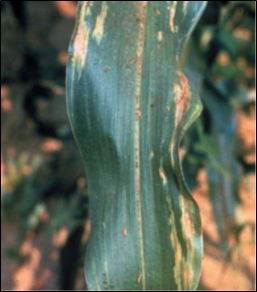Stewart's Wilt (Bacterial Wilt) in Corn
Bacterial Wilt (Stewart's Wilt)
Symptoms
Sweet corn is much more susceptible to Stewart's Wilt than field corn.
The disease is characterized by leaves showing pale green to yellow streaks with irregular or wavy margins that parallel the leaf veins. The streaks may extend the length of the leaf. These symptoms may resemble drought

Bacterial Wilt
University of KY Pesticide Applicator Training Slide Series
stress, nutrient deficiency or insect injury. Later, the streaked areas may die and become straw colored; sometimes entire leaves die and dry up.
Infections are most common early in the pre-tassel (whorl) stage, or after tasseling. Early season symptoms include plant death: seedlings infected with Stewart's Wilt wilt rapidly and die. Look for dark brown cavities in the lower stalk pith with no evidence of insect injury on the lower stalk. Infections after tasseling are generally more severe on upper leaves.
Lesions of Stewart's Wilt may be confused with unrelated lesions on hybrids carrying an Ht2 resistance gene to Northern Corn Leaf Blight . To aid in diagnosing Stewart's Wilt, hold leaves to the light and look in the lesions for scratch-like feeding marks of flea beetles (the transmission agents for the disease).
Cause
The causal agent of bacterial wilt is Erwinia stewartii which is transmitted by the corn flea beetle. The bacterium overwinters in the body of corn flea beetles and is spread by their feeding. The streak symptoms originate from feeding marks of the corn flea beetle. The disease is more prevalent following mild winters. In Kentucky, disease pressure is usually high, but if the winter is very cold so the flea beetles are killed, disease pressure will be significantly lower in the following growing season.
IPM Techniques
- Plants should be examined for Stewart's Wilt every four weeks from kneehigh through whorl stages and again every four weeks after tasseling until dent stage.
- Observe two rows of plants 10 feet in length at several representative locations. The number of random sites you should observe when scouting a field is based on the size of the field. To determine the number of scouting sites see Scouting Corn.
- Report the severity of the disease according to the following rating scale:
0 = no bacterial wilt symptoms;
1 = an occasional streak lesion on several plants or one dead plant;
2 = all plants contain bacterial wilt lesions on one or more leaves or 2 to 10% of plants dead;
3 = leaves severely wilted and dropping, nearly all leaves of all plants affected or over 10% of plants killed.
- Plant resistant hybrids and varieties.
- Early application of insecticides to control infestations of corn flea beetles is suggested.
References and Additional Information
- IPM-2 Kentucky IPM Manual for Corn
- PPA-10a Kentucky Plant Disease Management Guide for Corn and Sorghum by P. Vincelli and D.E. Hershman, Extension Plant Pathologists, University of Kentucky
- PPA-33 Stewart's Wilt of Corn by Donald E. Hershman, John R. Hartman and Richard E. Stuckey, Extension Plant Pathologists, University of Kentucky
- Compendium of Corn Diseases. M.C. Shurtleff. The Amer. Phytopathol. Soc. 1980
ENTFACT 302 - Sweet Corn Pests. Ric Bessin, Extension Entomologist, University of Kentucky


